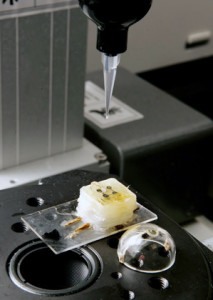To broaden the 3-D-printing palette, McAlpine’s group built its own printer; most of the ones on the market today are only designed to print plastic. “If you try to put other stuff in it, it will jam,” he says. They also needed to be able to print at a higher resolution. The bionic ear, for instance, had features on the millimeter scale—and to make LEDs they had to go to the micrometer sale.
To make the LED, the Princeton researchers chose quantum dots—semiconducting nanoparticles that emit very bright light in response to electrical current. They also used two kinds of metal to make electrical leads and contacts for the devices, as well as polymers and a silicone matrix to hold it all together. One challenge when printing with so many inks is the risk that they will bleed into each other. So the researchers had to make sure to suspend each material in a solvent that would not mix with any of the others.
McAlpine is using the new technique to make customized biomedical devices, some of which are being tested in animal studies. He declines to share the details of this unpublished work, but he adds that he’s also started making complex electronic devices using living cells.
See the full story here: http://www.technologyreview.com/news/532816/3-d-printing-bio-electronic-parts/?utm_campaign=newsletters&utm_source=newsletter-daily-all&utm_medium=email&utm_content=20141201